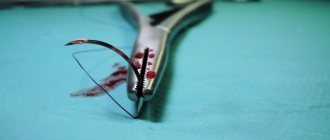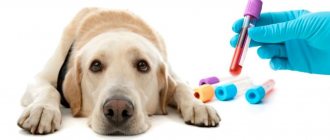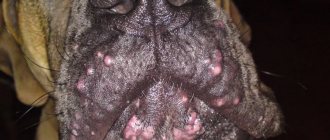There's been a lot of work this week, but in the rush you notice that your dog has been licking and chewing on one of his paws frequently for the last two days. You check them and realize that your dog's paws are red and sore. What the hell could be causing this?
Several things, actually. Dogs can have a red paw (or paws) for a variety of reasons. Some dogs have red paw pads due to injury, and some dogs have red paw pads due to conditions such as food allergies, fleas, contact dermatitis, parasites, secondary infections, and fungal infections.
Dogs may even develop red paws from boredom and canine anxiety. This is because when dogs are bored or anxious, they will often compulsively chew and lick their paws and feet for entertainment, unintentionally causing inflammation and irritation in the process.
Causes of red paws
If you're like most pet owners, the first thing you're probably wondering is what could red paws mean? Does this mean my dog is injured? Does this mean my dog has some disease that I don't know about? Let's look at the main reasons why a dog has red paws :
- pain;
- food allergies;
- contact dermatitis;
- parasites;
- boredom and anxiety;
- bacterial and fungal infections.
Below we will look at each of these reasons in detail.
Conclusion.
Prevention of interdigital dermatitis involves generally maintaining the health of the dog’s body. To do this, it is necessary to feed the pet properly and fully, give regular physical activity, and maintain a comfortable mental state of the pet. The best way to prevent infectious diseases is regular vaccination. As for parasitic diseases, monthly treatment with insecticides and quarterly treatment with anthelmintic drugs are required. If you notice signs of inflammation on your pet's paws, you should immediately show it to a veterinarian. Local treatment will not be effective unless the correct diagnosis is made. Moreover, it can even worsen the situation.
How pain causes red paws
A dog that has pain in one of its legs will chew and lick it in an attempt to relieve the discomfort. This may cause their paws to turn red. Most often you will only see one red paw if it is associated with pain. If you think your dog may be in pain, check his paw and find the source. Be sure to check the padding and between your dog's toes for any foreign objects or debris. Dogs can easily pick up things like thorns, burrs, rocks, glass shards or pieces of metal while outdoors, all of which can cause painful injuries.
© shutterstock
If you find anything foreign during your inspection, remove the offending object with tweezers, and then wash and disinfect your dog's paw to keep it free of dirt and germs. Be sure to keep a close eye on your dog. If you notice that the area where your dog's paw was injured looks like it is starting to swell, or it feels hot to the touch, or if it starts oozing any pus, contact your veterinarian immediately because these could be signs of a bacterial infection . Additionally, if your dog has torn a paw pad or has a deep cut that won't close on its own, your dog may need stitches.
Clinical manifestations of purulent inflammation
A complex of local symptoms of phlegmon of the left or right foot develops within several days from the moment of infection.
- Within two to three days, a tumor appears on the back of the foot in the form of a dense infiltrate, tissue edema forms, and bursting pain appears.
- Over time, the infiltrate softens in the direction from the center to the periphery.
- The skin in the affected area acquires a beet-red color with a local increase in tissue temperature.
- Palpation during examination causes pain; it is difficult for the patient to localize the source of inflammation.
- Attempts to move the leg, much less walk, are met with attacks of acute pain.
- The motor function of the foot is limited.
- The popliteal lymph nodes are enlarged.
In addition, clinical manifestations characteristic of most inflammatory processes develop quite quickly - an increase in body temperature to 39-40°C, decreased performance, weakness, headaches. If the process quickly spreads deeper, the patient’s condition worsens: shortness of breath and palpitations appear, intoxication syndrome develops, and urinary function is impaired. The patient needs immediate hospitalization.
Food allergies
Sometimes dogs develop red (and itchy) paws due to a yeast infection, often associated with some kind of food allergy. Dogs with this sensitivity have problems with grains in their food, such as corn, wheat or soy. If they do not tolerate one or more of these grains well, they will develop an allergic reaction and become vulnerable to secondary infection.
If you suspect an allergy and/or infection may be the cause, you may need to change your dog's food to treat the underlying food allergy, as well as see your veterinarian to treat your dog's yeast infection with medication. Your veterinarian can also offer additional tips to help keep your dog healthy and comfortable.
Fungal infections are also common in dogs with weak immune systems or in dogs suffering from an infectious hereditary disease. Both conditions can make them more susceptible than most dogs, and their paws are a favorite place for yeast to grow. They especially like the wet areas between your dog's toes and on your dog's feet. Be sure to check the rest of your dog's body as well because yeast can also grow in other areas such as your dog's groin, ears, and face.
Treatment methods
Due to the peculiarities of the anatomical structure of the foot, the purulent-inflammatory process quickly spreads throughout the lower limb and progresses. Therefore, immediate hospitalization of the patient is necessary for any form of pathology. Outpatient treatment of foot phlegmon is excluded, since the patient must be under constant medical supervision. Surgery and subsequent conservative therapy are performed in a medical institution.
The surgical operation consists of opening the source of inflammation, removing pus and necrotic tissue, washing and draining the resulting cavities. At the end of the procedure, an aseptic dressing is applied to the wound. Further treatment consists of the use of antibacterial and anti-inflammatory drugs, painkillers and restoratives. For phlegmon of anaerobic origin, the patient is administered anti-gangrenous serums. In case of severe intoxication, infusion therapy is indicated.
Since purulent tissue inflammation is a severe pathology, measures to prevent foot phlegmon are extremely important, which include:
- preventing foot injuries, even minor ones;
- using strong shoes with durable soles in traumatic situations;
- timely antiseptic treatment of injured areas;
- rapid identification of the inflammatory process and contacting a medical facility;
- timely treatment of any inflammatory foci in the body, including carious teeth, chronic tonsillitis, etc.;
- strengthening the immune system, treating immunodeficiency conditions.
How Contact Dermatitis Causes Red Paws
Contact dermatitis occurs when your dog's paws come into contact with something they are sensitive to and it irritates their skin. It could be literally anything in your dog's environment, from carpet and floor cleaners, certain fabrics and fibers, to salts found on icy roads, to irritants on your lawn (or your neighbor's lawn) that they react to.
These types of irritations are difficult to prevent because it can be difficult to narrow down what is causing the disorder. You can talk to your veterinarian about treatment options, and use natural products around the house and lawn to keep your dog's paws clean and free of irritants.
© shutterstock
Care and maintenance of your pet
During treatment, it is important to provide your pet with proper care and maintenance.
- Isolate the dog from external irritants in a separate room, sufficiently warm and well ventilated.
- Constantly change the litter to avoid spreading the infection.
- Make sure to disinfect the room daily.
- Maintain hygiene of affected skin areas.
- Use a collar to prevent your pet from scratching his wounds.
- If the dog cannot be bathed, you can wipe it with a damp cloth or potassium permanganate solution.
- Follow a strict diet, feed your pet a balanced vitamin food to replenish immunodeficiency. Decoctions of herbal immunomodulators can be given as a drink.
Care, maintenance and treatment of a dog at home should be carried out under the close supervision of a veterinarian.
How parasites cause red paws
Parasites such as ticks and fleas can take up residence in your dog's paws and bite their paw pads, driving your poor dog crazy. Since ticks cannot be seen with the naked eye, the veterinarian must magnify them. Dogs will give you clues when something is bothering them.
When a dog has parasites, even microscopic ones, they will lick or bite their paws in an attempt to get rid of them and relieve the itching and pain. Depending on the type of parasite, once you see your veterinarian, your dog may be given a monthly preventative treatment to rid him of the parasites.
Preventive measures
You need to keep an eye on your pet. After a walk, the paws should be washed and disinfected, and the hair between the toes should be trimmed.
- You need to watch what your dog eats. Nutrition should be complete and balanced.
- If your four-legged animal is kept in a kennel, you should clean it regularly.
- It is important to pay attention to any changes in behavior and, if necessary, take your pet to the clinic.
- If the cause is an allergen, it should be eliminated.
The therapy must be correct. Medicines are prescribed by a doctor, but dosages should not be exceeded. If your pet has an allergy, you should inform your veterinarian.
Currently reading:
- Thyroid dysfunction in dogs (hypothyroidism)
- Seven Signs and Remedies for Getting Rid of Fleas in Dogs
- The American Cocker Spaniel is an adroit hunter and loyal friend.
- Review for choosing carriers for small and large dogs
How boredom and anxiety cause red paws
If your dog is often left home alone for most of the day, he may bite and chew on his paws and claws out of sheer boredom. This gives them something to do and focus on. In other cases, the dog may become anxious or nervous when left home alone.
If your dog spends a lot of time alone, it's important to make sure they have plenty of toys and chews to play with to help distract them from chewing on things they shouldn't be chewing. (Like your furniture and paws.) You should also make sure that you allow your dog to get plenty of exercise when you are at home, so that when you leave, the dog will be tired and spend more time sleeping. This leaves them much less time to get into trouble.
Spread of pododermatitis and risk groups
All pets that have pads on their paws are susceptible to pododermatitis, but dogs suffer from the pathology most often. According to statistics, this is 80% of cases of visiting a veterinarian. Most often, owners of small and medium-sized dog breeds turn to the veterinary service. At the same time, the size and weight of the animal itself does not play a big role, the main thing is the pet’s lifestyle. As a rule, miniature dogs that walk on the street in handbags, shoes, or have no contact with the external environment at all, and for some reason have taken their first steps, become the main candidates for an appointment with a veterinarian.
It’s not for nothing that dogs also belong to the class of mammals; their body is built to a large extent in the same way as a human’s. They also have an immune system that protects them from many diseases. Their immunity, like ours, is capable of being renewed and strengthened every time. To do this, he must encounter various viruses, allergens, bacteria, and where do they come from in most cases in women's handbags?
Hence the main idea: a dog is an animal that originally lived in wild conditions and adapted to them, and excessive care can harm them.
Pododermatitis most often appears in dogs of the following breeds: Pekingese, Pug, Chihuahua, Papillon, Toy Fox Terrier, Spitz, Beagle and other decorative breeds. At the same time, it would be a mistake to think that only they can have this disease. It often affects large animals, working dogs, hounds, hunting, boxing breeds - such as Labrador, retriever, bullmastiff, Dalmatian, collie, German shepherd (less often), etc.
Bacterial and fungal infections
Another problem for dogs that causes red paws is bacterial and fungal infections. They often develop secondary infections due to their compulsive chewing and licking behavior. Bacterial infections in particular have a very foul odor, and you will likely notice pus and discharge, as well as inflammation and redness.
Both fungal and bacterial infections require a visit to the veterinarian so that the necessary antibiotics can be prescribed and the infection can begin to heal. Keep in mind that you need to be vigilant that your dog does not continue to lick and chew his paws, otherwise the infection may not heal properly. You may need to temporarily muzzle your dog or have him wear a conical collar. They won't be happy about it, but at least their poor feet will get some relief.
General information
The ICD-10 code for phlegmon of the foot is L03.0, and its immediate cause is infection of the foot tissue with bacteria that cause purulent inflammation. They penetrate into tissues:
- in case of damage to the skin in the form of an abrasion, scratch, crack, puncture or cut of the skin, abrasion caused by uncomfortable shoes;
- if the nail plate is damaged during a pedicure without observing proper aseptic requirements;
- when a foreign body enters soft tissue;
- from a ruptured abscess located elsewhere on the foot or leg;
- from a subcallosal abscess formed due to the appearance of a callus on the skin;
- through blood or lymph from a source of chronic infection in the body, which can be a carious tooth, boil, inflammation of the tonsils, etc.
In addition, the inflammatory process can be triggered by the penetration of certain chemicals into soft tissues, but such cases occur extremely rarely.
A number of pathogenic bacteria act as the causative agent of inflammation - staphylococci, streptococci, Escherichia coli, Pseudomonas aeruginosa, Proteus, etc. When infected with an anaerobic bacterium, the most severe gangrenous form of the pathology develops. Among the microorganisms that can cause inflammation, the most common are peptococci and clostridia.
All of these microorganisms cause acute purulent inflammation. There is also chronic phlegmon of the foot, which develops due to infection of soft tissues with pneumococci, diphtheria or paratyphoid bacillus.
A characteristic feature of the development of a purulent process is its spread: when the plantar part is affected, the inflammation often spreads to the phalanges of the toes or to the lower leg. Quite often the process is complicated by osteomyelitis. The infection spreads through the blood and lymphatic tracts, muscles, and tendons. All this makes phlegmon of the foot a pathology that creates an immediate danger to the patient’s life.
Diagnostics
Since a dog's paws can become red and inflamed for a variety of reasons, a visit to the vet may be your best option if you have any concerns or doubts about what you're dealing with. Once you take your dog to the vet, he or she will be able to use a variety of tests and methods to find out why your dog's paws look red.
© shutterstock
Typically, the veterinarian will begin with a physical examination, paying particular attention to the paws, since this is the area you are complaining about. This way they can see what's going on. If your dog has experienced hair loss associated with irritation, your veterinarian may use a microscope to examine the area and the hair follicle. Sometimes there may be a structural weakness in the hair itself.
The veterinarian may also take a skin sample from the affected paw to help them get a visual image under a microscope and determine if your dog has any parasitic, fungal, or bacterial infections on the surface of the skin. Of course, your veterinarian will also run standard tests such as a urinalysis, complete blood count, and full chemistry profile. These tests will help your veterinarian evaluate your dog's hormonal balance and check for any infections or signs that your dog's immune system has gone haywire in some way.
How to diagnose the disease
Immediately after discovering a problem, it is important to transport the animal to a clinic to determine the cause of the disease. A comprehensive examination and samples will be required. Qualified specialist assistance includes the following:
- biopsy;
- taking a cytological analysis;
- blood and urine collection;
- tests for susceptibility to antibiotics and allergic reactions.
In addition to laboratory work, a conversation is held with the owner about the dog’s diet, regimen and behavior. The diagnosis is made based on medical history and symptoms. Be sure to take a scraping of the affected area. Therapy is long-term, first of all to eradicate the cause. There is a possibility of relapse.
How to treat red paws
Treatment for your dog's red paws will obviously depend on what is causing the redness in the first place. If it involves contact with something, you will need to thoroughly wash your dog's feet to remove any contaminants. If there is a bacterial or fungal infection, you may need to use antibiotics or antifungal medications prescribed by your veterinarian.
Sometimes, if the inflammation and swelling is severe or your dog is in severe pain, your veterinarian may prescribe anti-inflammatories or corticosteroids as oral or injectable medications. The dog may also need medications to help regulate blood chemistry levels for any imbalances found there.
If your dog has a cut or laceration with a foreign body deeply embedded in its paw, surgery may be required to successfully remove it. Additionally, if your dog has any pustules or ruptured tumors that are causing redness and irritation, surgery may be required to remove them before proper treatment for pain and inflammation can be given.
Unfortunately, effective treatment can take days to weeks. Paw pad injuries and infections are problems to say the least because your dog has to walk. But walking not only exposes your dog to dirt, germs and bacteria, it also leaves him vulnerable to re-injury, depending on the original problem.
Prevention and treatment of dermatitis.
Preventive and therapeutic measures for dermatitis depend on the type and causes of the disease. Therefore, it is necessary to consider each type separately.
- Traumatic dermatitis. In urban living conditions, it is quite difficult to protect a dog’s paws from mechanical damage. During street walks, you constantly come across broken bottle glass, dangerous construction debris and other objects. When you receive injuries, it is important not to “start” the process, to carry out timely and competent treatment of wounds, to control their healing, preventing inflammation from becoming chronic. You need to know that the wound surface must be dry and well ventilated. To do this, when walking the dog, it is necessary to protect the damaged paw from moisture. Special boots will cope with this function perfectly. At home, shoes must be removed, since the wound must be in contact with air. It is also prohibited for the dog to lick the wound.
- Contact dermatitis. Dog owners often encounter this type of disease in winter, when the road is generously treated with de-icing chemicals. While walking, the dog may squeal and tuck its paws. Here it is important to completely eliminate contact of the animal’s skin with the chemical irritant. The best way is to use special boots for dogs.
- Allergic dermatitis. This is the most difficult type of dermatitis to diagnose and treat. In such a situation, if there is an allergy, the damage is always systemic in nature, that is, not only the paws are affected. Primary foci of the inflammatory process are found on the skin of the ears, the area around the eyes and mouth, and at the base of the tail. They can also be generalized, when almost the entire surface of the skin is affected. If you suspect a food allergy, you should definitely start a hypoallergenic diet. Feeds based on hydrolyzed protein are best suited here. The duration of diet therapy should not be less than 8-10 weeks. With a properly selected diet, during this long period of time, the allergen that causes inflammation stops entering the body, and regenerative processes begin. An improvement in the pet's condition is noted visually - the itching disappears, bald areas on the skin begin to grow back with hair. If this happens, then the diagnosis of food allergy is confirmed. If any positive dynamics are absent, we can talk about atopy - non-food allergies. Here, the allergen for the animal’s body can be any environmental factor, for example, pollen, house dust, poplar fluff, etc. It is not always possible to accurately identify the allergen, so first of all, the veterinarian prescribes treatment that helps eliminate secondary fungal or bacterial complications of allergies. Immunocorrective therapy (Forvet) can provide good help.
- Bacterial dermatitis. This is usually a secondary infection, which occurs when there is damage to the paw pads and interdigital folds, as well as if vitamin and mineral metabolism in the body is disrupted or there are hormonal changes.
- Staphylococcal dermatitis in dogs (pyoderma) is one of the most common diseases affecting the paws of dogs. The main causative agents of staphyloccal infection are St. aureus, St. albicans, St. Intermedium. These parasites can also be found on the skin of healthy animals. However, if immunity is at a normal level and the protective covering is in good condition, then pathological processes will not develop. If hormonal dysfunction or metabolic disorders are noted among the causes of the disease, then after eliminating this cause and with simultaneous antibacterial treatment of the secondary flora, recovery occurs quickly. Periodically, the infection can be generalized, that is, combined with otitis, scratching, conjunctivitis, hair loss, inflammation of the genital organs and inflammatory processes occurring in the paraanal glands. Here the main reason is immunodeficiency.
Only laboratory tests will allow you to most correctly and accurately establish the diagnosis. At the same time, it is very difficult to isolate staphylococcus from peripheral blood, since active staphylococcal persistence is observed in the blood only during sepsis. In case of generalized staphylococcosis, seeding from the ear canal or from skin ulcers also provides some information. The reason for this is their contamination with streptococci, Pseudomonas aeruginosa and other microorganisms. If generalized staphylococcosis occurs, then seeding from the genital organs will have the greatest effect, because this is where the pathogenic pathogen is definitely present. Staphylococcus isolated from an animal must have pathogenic properties - the ability to destroy red blood cells and clot blood plasma.
The diagnosis of staphylococcal dermatitis in dogs is made when characteristic clinical signs appear and positive laboratory test results are obtained. In this case, it is necessary to begin treatment immediately. For mild forms of this disease, for example, for superficial dermatitis, symptomatic treatment is sufficient. Skin lesions must be treated with antimicrobial agents with a drying effect, antiallergic drugs, and if severe itching occurs, with painkillers. If interdigital pyoderma occurs, applications of 50% dimethyl sulfoxide can be made. The doctor may also prescribe antibiotic therapy. It is important here that the isolated strain of staphylococcus is sensitive to the selected drug. However, experts recognize specific immunotherapy as the most effective way to treat staphylococcosis. It consists in the use of staphylococcal bacteriophage. It is also noted that with pyoderma, and especially if the skin is damaged quite deeply, corticosteroids can significantly complicate the course of the disease, since they suppress immune reactions. This is why doctors strongly recommend the use of immunomodulatory drugs (Forvet).
In addition, treatment of staphylococcosis must be combined with the use of antifungal drugs that suppress the development of yeast-like fungi of the genus candida or malassezia. Indeed, for the latter, ideal conditions are created in the interdigital spaces for growth and parasitism, since it is there that the humidity is slightly increased and the temperature is relatively higher.
- Parasitic dermatitis. The following parasites are often the culprits of this type of dermatitis in dogs:
Sarcoptes canis is a skin mite that causes sarcoptic mange. With this disease, the animal's head is primarily affected, especially in the area around the eyes and mouth, nose and ears. Small nodules appear on these areas of the skin, which gradually fill with fluid. The lesion may then appear in the groin area, paws and armpits. The disease has a number of unpleasant symptoms: severe itching in the affected area, hair loss in specific areas, and the appearance of bloody crusts. Treatment in this case is carried out by external treatment of damaged areas on the animal’s body with insecto-acaricidal preparations.
- Demodex canis are small, worm-shaped mites that parasitize the sebaceous glands and hair follicles of the skin. With the slightest weakening of the level of immunity in the body, the number of parasites increases sharply and signs of the disease immediately begin to manifest themselves. As in the case of sarcoptic mange, lesions first appear on the head, in the groin, axillary area, and in the interdigital folds. It is also possible for the disease to develop in a generalized form, in which demodectic mites in dogs appear in the lymph nodes, kidneys, liver, spleen, and intestinal walls. In this case, treatment is difficult and takes quite a long time.
- Hookworms - small nematodes Ancylostoma caninum and Uncinaria stenocephala - with their toxic effects on the body can also cause dermatitis. They parasitize domestic and wild carnivores in the small intestine. In this case, serious skin damage is observed in different parts of the body. Treatment is carried out mainly with anthelmintic drugs.
- Psychogenic dermatitis. This type of disease affects animals that have a delicate nervous system. In cases where a pet has difficulty moving from place to place, separation from its owner, and other unusual situations and events, it needs to be given sedatives prescribed by a veterinarian. This helps you cope with stress without harmful consequences to your health. This type of dermatitis has been studied less than all others.
Diseases associated with impaired skin integrity
The coat makes it difficult to control the condition of the dog's skin. Often the first sign to contact a specialist is the appearance of dandruff. In this case, dandruff can be an independent disease or a symptom of another disorder in the body.
The most common is dermatosis - a pathological process of a degenerative nature, characterized by constant itching. The main causes of the disease are allergic reactions, pyoderma, scabies, and atopy.
Dermatosis is divided into primary and secondary. Primary is based on the hereditary predisposition of certain breeds - golden retrievers, Labradors, terriers, poodles and others.
Secondary dermatosis is associated with metabolic disorders in the body and chronic pathologies. Typically, the use of medications is required throughout life, this allows you to get rid of relapses.
Treatment methods for molluscum contagiosum
Molluscum contagiosum should be treated by a doctor. You should not try to remove papules yourself - this can lead to bacterial infection.
Treatment of molluscum contagiosum depends on a number of factors, primarily on the stage of development of the disease, the severity of symptoms and the state of the patient’s immunity. The following methods can be used:
Instrumental removal
Papules can be removed instrumentally, followed by treating the wound with antibacterial agents.
Credestruction
Cryodestruction is the removal of papules using exposure to low temperatures. Papules are treated with liquid nitrogen. Tissues treated in this way freeze and die.
Radio wave removal
Molluscum contagiosum papules can be removed using the radio wave method (using the Surgitron apparatus) and using a laser.
Electrocoagulation
Electrocoagulation is the effect of high-frequency current on papules. It is popularly described as “cauterization with electricity.” At the moment of discharge, a local strong thermal effect occurs, the tissues coagulate, which virtually eliminates the risk of infection at the treatment site.
Conservative treatment
The course of treatment for molluscum contagiosum may include conservative treatment with ointments and creams, as well as taking antiviral drugs (if the affected area is large).
Make an appointment Do not self-medicate. Contact our specialists who will correctly diagnose and prescribe treatment.
Rate how useful the material was
thank you for rating
Symptoms of interdigital dermatitis in dogs
One of the symptoms of pododermatitis in dogs is interdigital dermatitis.
Interdigital dermatitis is characterized by redness of the skin.
Clinical signs that may indicate a problem:
- reddened skin between the toes and on the toes themselves, paw pads;
- thinning hair in affected areas;
- swelling of the limb and itching, which the dog tries to stop by licking;
- weeping wounds, fistulas and boils may appear between the fingers;
- Pain in the limbs when walking can result in limping.
Causes
Paw injury can cause dermatitis.
There can be many causes of skin problems on the paws of dogs. The most common of them:
- Trauma . A dog can injure a limb, cut itself on glass while walking, or get burned. Irritation from scratching and bruising cause dermatitis. In such cases, a disease of traumatic origin is diagnosed. Injury can be caused by the pet being overweight, when the support during walking is not on the pads, but on the skin.
- Not only people are susceptible to allergic reactions . Dogs are very sensitive to allergens, so contact with an irritating substance leads to redness, swelling of the limb and even the appearance of a rash. By eliminating the influence of the allergen, you can achieve a quick cure for the animal. The allergic reaction is very similar to eczema, but in the case of the latter, the inflammatory process is chronic.
- Bacterial infection . It could be staphylococcus or candidiasis.
- Penetration of the parasite under the skin is fraught with the occurrence of dermatitis . Most often this parasite is a tick.
- Dogs are creatures capable of feeling and experiencing. An emotional outburst can be caused by separation from the owner, his death, or a change of place of residence. The appearance of dermatitis in this case is caused by psychogenic factors .
- Autoimmune diseases and cancer lead to decreased immunity and cause skin problems.
- Vascular diseases , for example, vasculitis.











